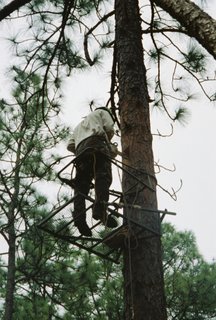
Four excerpts from Chapter Two
A Prescribed Burn
Excerpt 1: The Briefing
A weekday in early April, 7:30 a.m. I received a call from refuge manager Scott Lanier. Conditions looked good for a prescribed burn at the Carolina Sandhills NWR, and he invited me along. . . .
An hour later, I was with Scott at the refuge headquarters in the cab of a white 4x4 US Fish and Wildlife Service truck, looking at a xeroxed map of Carolina Sandhills NWR Compartment 17. . . .
“Today is a growing season burn,” he explained, “as opposed to a dormant, winter burn. Research shows that fire often occurs in the growing season. We try to mimic that. It helps curtail the oaks, which are sucking up nutrients from the soil and budding out. Our goal is not to eradicate the oaks, but to control them. Oaks are part of this habitat and provide mast--acorns--for animals.
“If we burn at this time, the fire will kill a lot of the oaks. We haven’t pushed the envelope, though, and burned in summer. You can really torch your pines if the conditions--moisture, fuel, and temperature--aren’t perfect.” . . .
The burn crew consisted of 6 men and 2 women--firefighters not only from the Carolina Sandhills NWR but from as far away as Savannah. Of these 8, 3 would be in the helicopter.
Excerpt 2: “We can’t strike a match without getting that son-of-a-gun signed.”
I shook hands with Terri Jenkins, a Fire Management Officer from the Savannah Coastal Refuges Complex and the helicopter’s burn boss. . . . In addition to herself and the pilot, a third crew member ran the “ping-pong ball machine,” a curious rectangular steel contraption bolted to the side opening of the helicopter and designed not only for starting burns but for fighting wildfires. Officially, the ping-pong ball machine is known as the Premo Mark III Aerial Ignition Machine. . . .
“The Sandhills are particularly adapted to the use of this system,” Terri said. “There’s good leaf litter for the balls to ignite in. The balls are used not only for prescribed burns,” she added, “but also for fire suppression.” A wildfire can be suppressed by starting a burn on a forest floor to consume the fuel before the wildfire can reach it. . . .
Later, back at the refuge office, I had an opportunity to talk with Patricia McCoy, the NWR’s accountant, administrative assistant, and dispatcher. Patricia is stationed in the headquarters, and her role in a burn is to monitor weather reports, obtain state approval to burn, coordinate communication between the ground and helicopter crews, and deal with a mountain of paper work. . . .
Excerpt 3: Laying Down the Line
We drove on down a maze of dirt roads deeper into the forest. Ahead, smoke was boiling out from the woods. A fire engine sat at a crossroads. The ground crew, highly visible in their yellow fire-retardant Nomex shirts, had started a prescribed burn at Unit 9.3. We parked near a scorched swath of land which paralleled the road bed and stepped out of the truck.
Striding fast along the fire break--in this case, a dirt road--the crew was creating a “black line” about 20 yards wide by pouring fire onto the ground cover from drip torches, canisters of “slash fuel,” a diesel and gas mixture in a 3:1 ratio. When tilted, the torches dripped fire from metal spouts tipped with wicks. . . .
Excerpt 4: The Burn
I had been to the refuge often, hiking, fishing, hunting, and biking; but I’d never seen it like this. It was a Dantesque scene of an inferno. The ground was smoldering black. Three-foot flames licked at the tree trunks. The yellow-shirted, smoke-smudged crew tramped through the firebreak, setting fire to any patch of wiregrass that hadn’t yet caught. A yellow fire engine, red lights flashing, stood sentinel on the dirt road.
I looked on from the firebreak with Scott and Mark Parker, the ground burn boss, and watched the thick gray smoke roiling into the sky and wondered how the devil the helicopter crew could see to drop its pattern of fireballs into the burn zone. . . .
I asked if any animals take a hit in the burns. Mark paused. “There’s always a possibility of killing a few. But on a refuge that’s 45,000 acres, the benefit of new growth outweighs the small amount of loss.” The argument is, it’s better for wildlife to suffer small, periodic burns than one catastrophic wildfire which kills an entire forest community. . . .




